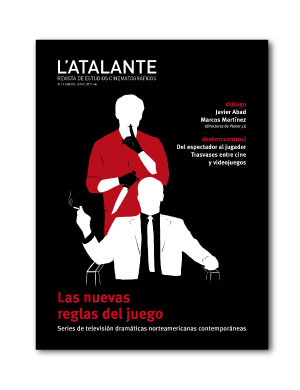Publicado 01.01.2011
Palabras clave
- Dexter,
- psicopatía,
- monstruosidad,
- cotidianidad,
- ironía
- ficción televisiva,
- títulos de crédito,
- sangre ...Más
Cómo citar
de Felipe Martínez, P. (2011). Dexter: ironía, cotidianidad y monstruosidad. L’Atalante. Revista De Estudios cinematográficos, (11), 31–37. https://doi.org/10.63700/110
Resumen
¿Podemos como espectadores identificarnos con un personaje principal psicópata y asesino en serie? ¿Por qué sentimos simpatía por él? Este artículo argumenta cómo cotidianidad y monstruosidad se ven engarzadas en Dexter por la ironía, que junto a la extrañeza del personaje principal ante las convenciones sociales y relaciones humanas, y el hecho de que, aunque profundamente oscuro, sea un héroe emocionalmente desvalido, hacen de él uno de los personajes televisivos actuales más divertidos y atrayentes.
Descargas
Los datos de descargas todavía no están disponibles.
Citas
BOYLE, Fiona (2010). Blood Brothers: Brian + Dexter + Miguel. En HOWARD, Douglas L. (ed.), Dexter: investigating cutting edge televisión (pp. 96-113). Nueva York, Londres: I.B. Taurus.
BRILLA, Catalin (2010). Why do we love Dexter Morgan in the morning. The Art of the Title Sequence. Recuperada de www.artofthetitle.com/why-do-we-love-dexter-morgan-inthe-morning/.
GOLDTEIN, Sarah A. (2009). Not Your Average Criminal: Dexter, Weeds and The Sopranos, Challenching Traditional Media Portrayals. Tesis doctoral. Burnaby (Canadá): Simon Fraser University.
HADDON, Mark (2004). El curioso incidente del perro a medianoche. Barcelona: Salamandra.
HILL, Shona y SMITH, Shilinka (2009). Fearful Irony: The Case of Being Dexter(ous). En FRANKLIN, Leanne y RICHARDSON, Ravenel (ed.): The Many Forms of Horror, Fear and Terror (pp. 93-102). Inter-Disciplinary Press. Oxford: 2009.
HOWARD, Douglas L. (ed.) (2010). Dexter: investigating cutting edge televisión. Nueva York, Londres: I.B. Taurus.
LINDSAY, Jeff (2006). Querido Dexter. Barcelona: Ediciones Urano.
PEACOCK, Steven (2010). Dexter’s Hollow Designs. En HOWARD, Douglas L. (ed.), Dexter: investigating cutting edge televisión (pp. 49-58). Nueva York, Londres: I.B. Taurus.
PEIRSE, Alison (2010). In a lonely place? Dexter and film noir. En HOWARD, Douglas L. (ed.), Dexter: investigating cutting edge televisión (pp. 189-204). Nueva York, Londres: I.B. Taurus.
RAMOS BRASILIENSE, Ramone (2009). Os sentidos midiáticos da ordem e da monstruosidade em Dexter. Revista da Associação Nacional dos Programas de Pós-Graduação em Comunicação | E-compós, v.12, n.3, set./dez. Brasilia. Recuperada de www.e-compos.org.br.
TEUTEBERG, Jasmin (2009). America’s favourite serial killer. The Creation of Sympathy in the Perception of Criminals in Television Crime Narratives – Exemplified by the Series Dexter. Tesis doctoral. Estocolmo, Suecia: Stockholm University, JMK. www.showtime.com http://www.pizquita.com/listadocapitulos-777.html.
BRILLA, Catalin (2010). Why do we love Dexter Morgan in the morning. The Art of the Title Sequence. Recuperada de www.artofthetitle.com/why-do-we-love-dexter-morgan-inthe-morning/.
GOLDTEIN, Sarah A. (2009). Not Your Average Criminal: Dexter, Weeds and The Sopranos, Challenching Traditional Media Portrayals. Tesis doctoral. Burnaby (Canadá): Simon Fraser University.
HADDON, Mark (2004). El curioso incidente del perro a medianoche. Barcelona: Salamandra.
HILL, Shona y SMITH, Shilinka (2009). Fearful Irony: The Case of Being Dexter(ous). En FRANKLIN, Leanne y RICHARDSON, Ravenel (ed.): The Many Forms of Horror, Fear and Terror (pp. 93-102). Inter-Disciplinary Press. Oxford: 2009.
HOWARD, Douglas L. (ed.) (2010). Dexter: investigating cutting edge televisión. Nueva York, Londres: I.B. Taurus.
LINDSAY, Jeff (2006). Querido Dexter. Barcelona: Ediciones Urano.
PEACOCK, Steven (2010). Dexter’s Hollow Designs. En HOWARD, Douglas L. (ed.), Dexter: investigating cutting edge televisión (pp. 49-58). Nueva York, Londres: I.B. Taurus.
PEIRSE, Alison (2010). In a lonely place? Dexter and film noir. En HOWARD, Douglas L. (ed.), Dexter: investigating cutting edge televisión (pp. 189-204). Nueva York, Londres: I.B. Taurus.
RAMOS BRASILIENSE, Ramone (2009). Os sentidos midiáticos da ordem e da monstruosidade em Dexter. Revista da Associação Nacional dos Programas de Pós-Graduação em Comunicação | E-compós, v.12, n.3, set./dez. Brasilia. Recuperada de www.e-compos.org.br.
TEUTEBERG, Jasmin (2009). America’s favourite serial killer. The Creation of Sympathy in the Perception of Criminals in Television Crime Narratives – Exemplified by the Series Dexter. Tesis doctoral. Estocolmo, Suecia: Stockholm University, JMK. www.showtime.com http://www.pizquita.com/listadocapitulos-777.html.

